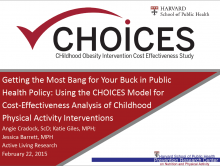This workshop explored the CHOICES (CHildhood Obesity Intervention Cost Effectiveness Study) model of cost-effectiveness analysis and lead participants through a process for assessing physical activity policies in meaningful ways for decision makers. The goal of the CHOICES project is to identify cost-effective interventions that will improve child physical activity and nutrition behaviors, reverse the obesity epidemic, and reduce healthcare costs associated with obesity and inactivity. Using a common set of metrics and the best available scientific evidence, CHOICES is generating cost-effectiveness estimates for 40 childhood obesity prevention interventions in a range of settings where children spend their time. Workshop presenters walked participants through the step-by-step CHOICES process, demonstrating through examples of physical activity policies how effectiveness, reach (specific populations impacted by an intervention), and cost interact in a cost-effectiveness analysis. With guidance from CHOICES team members, participants developed an intervention specification and logic pathway to evaluate the available evidence for interventions and identify research gaps and defined and enumerated the population reached by the proposed interventions. After presenters described key principles and processes for identifying the costs associated with interventions, participants worked together in teams to apply these to specific interventions.








